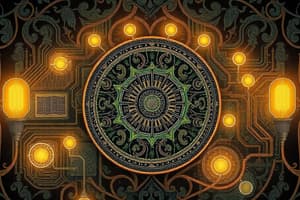Podcast
Questions and Answers
What is the primary function of a resistor in an electronic circuit?
What is the primary function of a resistor in an electronic circuit?
- To allow current flow in one direction
- To amplify signals
- To limit current flow (correct)
- To store electrical energy
Which unit is used to measure capacitance?
Which unit is used to measure capacitance?
- Ohms
- Farads (correct)
- Henries
- Volts
What type of component is an inductor?
What type of component is an inductor?
- Limits current flow
- Amplifies signals
- Stores energy in a magnetic field (correct)
- Regulates voltage
What is the function of a diode in a circuit?
What is the function of a diode in a circuit?
What is the main purpose of a microcontroller?
What is the main purpose of a microcontroller?
Which type of communication transmits data one bit at a time?
Which type of communication transmits data one bit at a time?
What is the role of sensors in an electronic system?
What is the role of sensors in an electronic system?
What should be done before making changes to an electronic circuit?
What should be done before making changes to an electronic circuit?
Flashcards are hidden until you start studying
Study Notes
Basics of Electronics
- Definition: Electronic circuits manage the flow of electrons in a material.
- Fundamentals:
- Voltage (V): Electrical potential difference.
- Current (I): Flow of electric charge.
- Resistance (R): Opposition to current flow.
Key Components
-
Resistors
- Limit current flow.
- Measured in ohms (Ω).
- Fixed or variable types (potentiometers).
-
Capacitors
- Store and release electrical energy.
- Measured in farads (F).
- Types: electrolytic, ceramic, tantalum.
-
Inductors
- Store energy in a magnetic field.
- Measured in henries (H).
- Used in filters and transformers.
-
Diodes
- Allow current to flow in one direction only.
- Types: standard, Zener (regulates voltage), Schottky (fast switching).
-
Transistors
- Act as switches or amplifiers.
- Types: bipolar junction (BJT), field-effect (FET).
- Fundamental for digital circuits.
-
Integrated Circuits (ICs)
- Miniaturized circuits on a single chip.
- Common types: analog ICs, digital ICs, microcontrollers.
Power Supply
- Types:
- AC (Alternating Current): Varies sinusoidally (e.g., wall outlets).
- DC (Direct Current): Flows in a single direction (e.g., batteries).
- Transformers: Change AC voltage levels.
Circuit Design
- Schematic Diagrams: Visual representations of electronic circuits.
- Breadboards: Prototyping tools for building circuits without soldering.
- Design Considerations: Power requirements, signal integrity, temperature effects.
System Components
-
Microcontrollers
- Embedded systems capable of processing commands.
- Used in automation, robotics, and IoT devices.
-
Sensors
- Detect environmental changes (temperature, light, motion).
- Types: analog and digital sensors.
-
Actuators
- Convert electrical energy into physical motion.
- Common types include motors and solenoids.
Communication Protocols
- Serial Communication: Transmits data one bit at a time (e.g., UART, SPI).
- Parallel Communication: Transmits multiple bits simultaneously.
- Wireless Communication: Includes Bluetooth, Wi-Fi, and Zigbee.
Troubleshooting
- Common methods:
- Check connections.
- Measure voltage and current at various points.
- Use multimeters and oscilloscopes for diagnostics.
Safety Considerations
- Understand electrical standards and regulations.
- Always disconnect power before making changes.
- Use protective equipment as needed (gloves, goggles).
Final Notes
- Familiarity with electronic components and their functions is critical for any electronics-related projects.
- Hands-on practice and experience are essential for mastering electronics and system components.
Basics of Electronics
- Electronic circuits manage the flow of electrons in a material.
- Voltage (V), Current (I), and Resistance (R) form the foundation of electronics.
Key Components
- Resistors limit current flow and are measured in ohms (Ω).
- Capacitors store and release electrical energy and are measured in farads (F).
- Inductors store energy in a magnetic field and are measured in henries (H).
- Diodes allow current flow in one direction.
- Transistors act as switches or amplifiers.
- Integrated Circuits (ICs) are miniaturized circuits on a single chip.
Power Supply
- AC (Alternating Current) varies sinusoidally, while DC (Direct Current) flows in a single direction.
- Transformers change AC voltage levels.
Circuit Design
- Schematic Diagrams visually represent electronic circuits.
- Breadboards are prototyping tools for building circuits without soldering.
- Design considerations include power requirements, signal integrity, and temperature effects.
System Components
- Microcontrollers are embedded systems with processing capabilities.
- Sensors detect environmental changes.
- Actuators convert electrical energy into physical motion.
Communication Protocols
- Serial Communication transmits data one bit at a time.
- Parallel Communication transmits multiple bits simultaneously.
- Wireless Communication options include Bluetooth, Wi-Fi, and Zigbee.
Troubleshooting
- Common troubleshooting methods involve checking connections, measuring voltage and current, and using diagnostic tools.
Safety Considerations
- Understand electrical standards and regulations.
- Disconnect power before making changes.
- Use protective equipment.
Studying That Suits You
Use AI to generate personalized quizzes and flashcards to suit your learning preferences.




